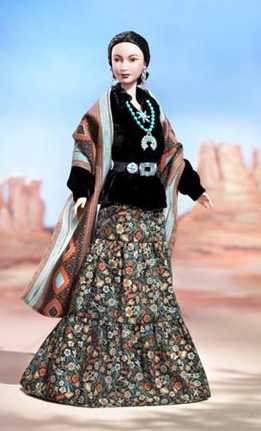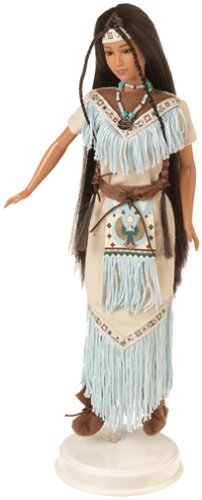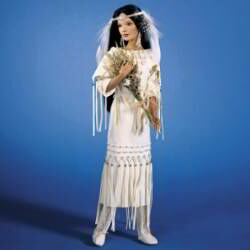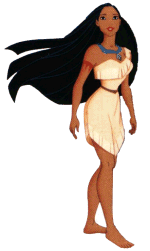 Another Stereotype of the Month entry:
Another Stereotype of the Month entry:
 Another Stereotype of the Month entry:
Another Stereotype of the Month entry:
Princess of the Navajo Barbie Doll
Princess of the Navajo Barbie Doll from the Dolls of the World Collection. In the western United States a peaceful culture of Native American Indians thrives. Rooted in ancient traditions of respect for the land and nature as well as a powerful spiritual heritage, the tribal people known as the Navajo, endures. Barbie doll is dressed as a princess of the proud Navajo Nation wearing traditional dress and authentic jewelry. Many Navajos continue to wear traditional clothing daily and especially for ceremonial or social gatherings. Barbie doll wears a woven shawl in ceremonial colors with symbolic and stylized patterns. Barbie doll also wears a necklace of turquoise-colored beads with a "squash blossom" pendant and a "concho" belt in silver and turquoise tones with earrings and a sunburst broach. The long printed skirt and dark open-necked shirt are consistent with everyday wear for most Navajo women even today.
Comes packaged in the new Pink Label display box.
From year 2004. Pink Label
From the Navajo Times, 9/30/04:
'Navajo Barbie' sells out at area stores
By Levi J. Long The Navajo Times
GALLUP -- Wearing a chocolate brown velveteen shirt, a long floral skirt and "silver and turquoise" jewelry, the new Navajo Barbie doll is a hit.
But this isn't the blonde, blue-eyed doll icon of toy land. Instead this dark haired and caramel skinned doll has her tresses tied in a traditional Navajo bun.
And instead of an evening stole, her shoulders are warmed by a Navajo designed shawl.
The only thing missing are her moccasins and her Pink Window Rock Dream Hogan.
Three weeks ago the Navajo Barbie doll went on sale at national discount stores and toy shops around the country.
But good luck if you're trying to find one. Most of the major retailers at surrounding reservation stores were sold out, even though more than 50,000 were made.
At the Super Wal-Mart store in Gallup, one of the largest stores in the country whose customers are mostly Native American, the doll sold out within hours on Monday.
"We put out 50 of them in a special display and by the end of the day they were gone," said Eugene Orr, a co-manager at the store.
The super store ordered 500 dolls when they first came out last month.
"We knew it was going to be a seller because it symbolizes the area," said Crystal Wade, assistant manager at Wal-Mart.
Gerren Gishi, a sales associate in the toy department, said customers have been asking him about it.
"As soon as we have them, some people put them on lay-a-way in twos or threes," Gishi said.
The doll can be found at other major retailers like Target and at on-line Web sites like www.walmart.com. It retails for $19.99.
This isn't the first time doll mania has hit the Navajo Nation.
In 1999, Hasbro introduced a Navajo Code Talker "action figure" as part of its G.I. Joe line.
But this is the first time Mattel, the maker of Barbie, has introduced a Navajo doll as part of its collection, said Elizabeth Grampp, senior manager of Barbie Collector at Mattel.



"The Princess of the Navajo" is part of the Dolls of the World Princess Collection and other dolls in the series include a princess of Cambodia and Ancient Mexico.
Other American Indian dolls featured Native Americans from Plains, Northwest and Alaskan Native tribes.
"The Navajo Nation is a wonderful representation of Native American culture," said Grampp. "The costume offered opportunities for rich historical details, like the unique belt ornamentation and the turquoise style necklace."
Grampp didn't say how the doll was researched or if there were any Navajos who were part of the design process, except to note that artists at Mattel designed the dress.
Historical details of the Navajo Tribe are included on the doll's box.
The inside of the box features a painting of mesas and blue skies. On the back of the box there is story of the Navajo princess.
"A beautiful young girl with long dark hair and sparkling brown eyes lives in the desert of the American Southwest," the box reads. "She is a Navajo, or as she would say, Diné, which means 'the people.'"
The story talks about her father, the "chieftain," or Naatani, of the tribe and talks about the hogan.
There are also other Navajo words and phrases like Ya'ateeh' and Dinebizaad in the story.
The only misspelling seems to be with the Blessingway ceremony, which they spell "H zh ji Hane," and should be "Hozhoji Hane," which speaks about the celebration of the birth of a baby.
Besides that error customers were pleased to see the doll.
With her eyes shining, six-year-old Talia Bowman dropped a book she was holding and looked in awe at the doll on a shopping trip with her mom.
"It's a Navajo doll," she said, pointing at the box.
Dennette Bowman, her mother, collects porcelain dolls, and said this doll could be used as a teaching tool.
"(Talia) would learn more about the culture as far as what Navajo women wear," Bowman said. "There are stories behind this belt, squash blossom, earrings and bun."
Bowman said the Navajo doll's clothes represent the women well, instead of the "skimpy clothes" the other Barbie's wear.
"(Talia)'s friends say, 'I want to dress like Barbie,'" Bowman said, much to her displeasure. "But this Navajo doll presents a more positive image. I'd like to see more of that."
Charlene Morgan, shopping with her 3-year-old daughter Francesca, said they would buy the doll for special occasions.
"This would be good for souvenirs," she said. "If one of my sisters gets married I'd give to them as a gift."
Clarence Tsosie, a father with two daughters and one son, said he'd buy it, but only for his wife, he said laughing.
Shelia, Tsosie's wife, said it was too nice to take out of the box. "It's unique and it's so pretty," she said and then laughed. "But I wouldn't like them play with this one."
Crystal Redgrave, a kindergarten teacher at Tse Ho Tso Primary School in Fort Defiance, said the Navajo doll represents all Native American women well.
Redgrave, who is from the Assiniboine Nation of Montana, said Native women have always been underrepresented.
"Indian women need to be represented," she said.
Describing herself as a feminist, she said she had mixed feelings about Barbie dolls.
"Some people are against Barbie dolls, but I remember playing with them as a child," she said. "And I think this is beautiful. It symbolizes what young girls can aspire to be and embrace and says we're still in existence."
Rob's reply
The biggest problem here is calling the Navajo Barbie a princess. Most tribes didn't have princesses and the Diné weren't the exception. That any prominent female must be a princess or a chief's daughter is an age-old stereotype.
|
. . . |

|
All material © copyright its original owners, except where noted.
Original text and pictures © copyright 2007 by Robert Schmidt.
Copyrighted material is posted under the Fair Use provision of the Copyright Act,
which allows copying for nonprofit educational uses including criticism and commentary.
Comments sent to the publisher become the property of Blue Corn Comics
and may be used in other postings without permission.